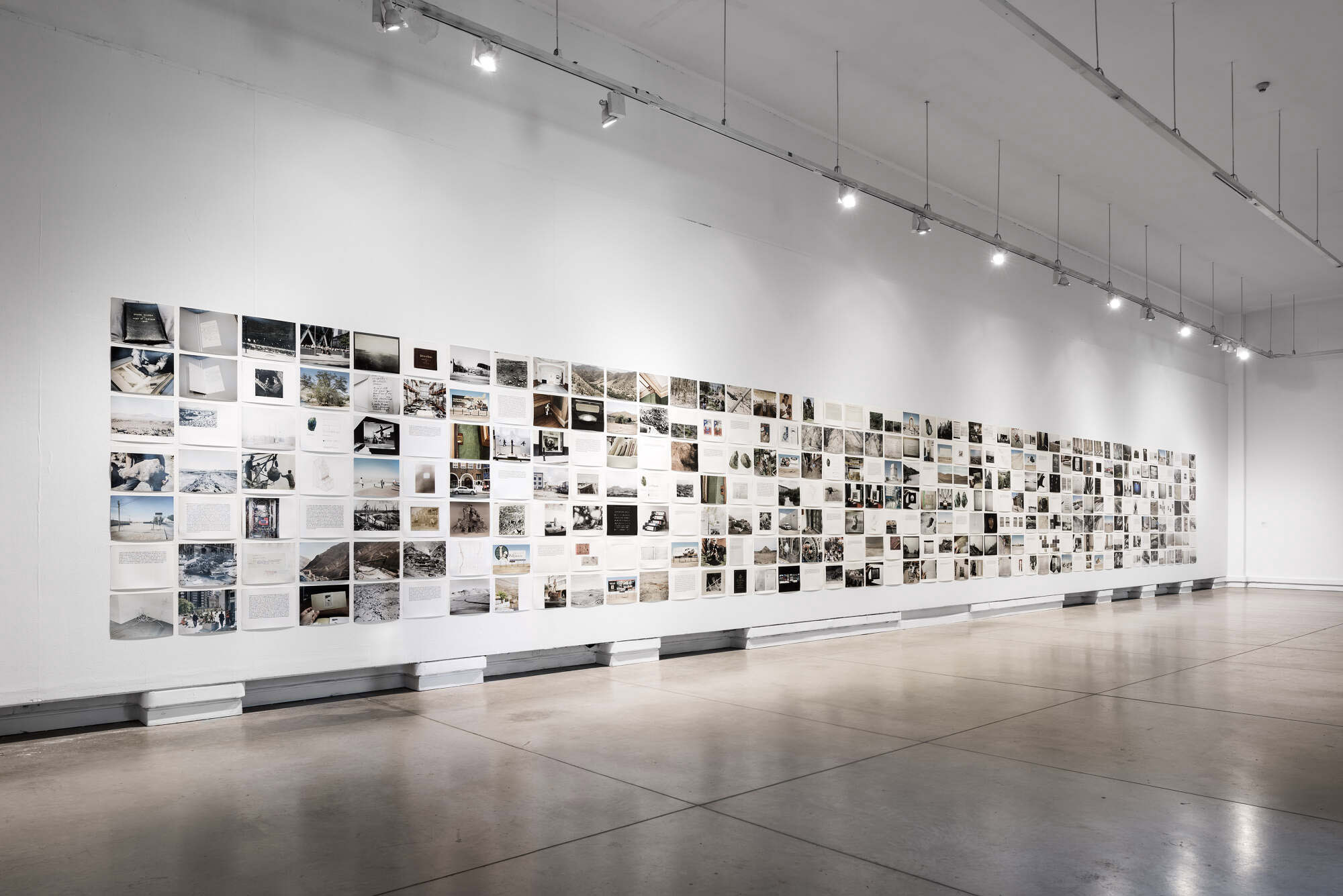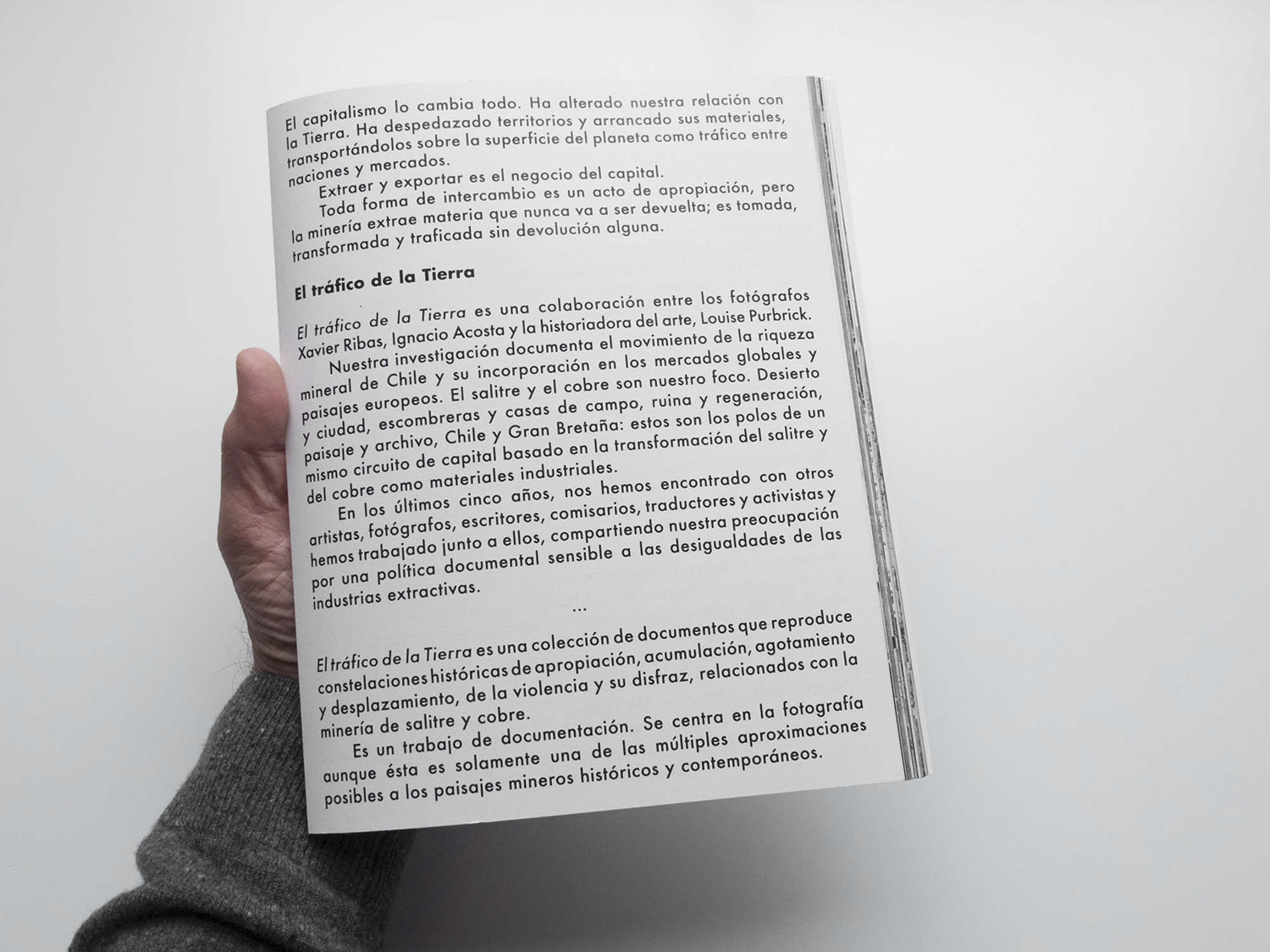© XAVIER RIBAS - Trafficking the Earth (with Louise Purbrick and Ignacio Acosta), 336 images and texts, 35,5 x 27,5 cm each, vinyl text. Edition of 3

Trafficking the Earth, Installation Museo de Arte Contemporáneo Universidad de Chile, Santiago. September 2017
Capitalism changes everything. It has altered our relationship to the Earth. It has ripped lands apart, torn out their materials and hauled them over the surface of the world as the traffic between nations and within markets. Extraction and export is the business of capital. All forms of exchange are acts of appropriation but mining removes material that can never be replaced; taken, transformed and trafficked with no intent to repay.
Trafficking the Earth is a collaboration between photographers Xavier Ribas, Ignacio Acosta and an art historian, Louise Purbrick. Their collective research has documented the movement of mineral wealth of Chile into global markets and European landscapes. Nitrate and copper is their focus. The transformation of these natural resources into industrial materials draw desert and city, slag heap and country house, ruin and regeneration, landscape and archive, Chile and Britain, into the same circuit of capital. Over the last five years Acosta, Purbrick and Ribas have encountered other artists, photographers, curators, translators and activists and worked alongside them sharing a concern with politics of documenting the inequalities of extractive industries.
Trafficking the Earth is a collection of documents that reproduces historical constellations of appropriation and accumulation, depletion and displacement, violence and its disguise, begun by mining nitrate and copper. Our work is documentation. Photography is our focus but it is only one type of document in historical and contemporary mining landscapes. A photograph is a trace, an imprint of time and space, but as Walter Benjamin wrote, ‘to live is to leave traces’ and the documents of nitrate and copper are found in many places, preserved and obscured. The Atacama Desert, the Pacific ports of Iquique and Pisagua, mining town of Chuquicamata, the slag heaps of Coquimbo, the City of London, the docks of Liverpool, the waterfront of Swansea, First World War munitions factories and battlefields, English country estates and Oxford Colleges may appear as separate geographies yet they are entangled together in the transport and transformations of nitrate and copper.
The rupture of mining the Earth and trafficking in the Earth’s substance sets in motion material transformation upon material transformation as the operations of industrialisation and the manipulations of commoditisation use up both land and labour: ore into metal, rock into chemical, chemical into commodity, metal into exchange, natural substance into industrial form, and finally into the arbitrary abstractions of the global market: only a value, merely a share price. Once nitrate is dug into soil to feed cattle fodder or poured into the explosive mixtures that make dynamite, once copper disappears into cables encased in plastic and is embedded within the intricate internal wiring of lap tops and smart phones, only their market value appears to remain: they are capital; they have become capitalised forms, invisible as anything else.
But nothing ever really disappears. Every act of appropriation is found in the land: in ruins and residue. Ecological contamination is historical evidence. A trace. The entangled geographies of desert, port and city are also entwined histories. Trafficking the Earth traverses past and present, one folds into the other in constant transformation.
+
PDF [Cas]
Trafficking the Earth was produced by Ignacio Acosta, Louise Purbrick and Xavier Ribas as part of their AHRC funded project Traces of Nitrate. Mining History and Photography Between Britain and Chile, developed at the University of Brighton.
For more information about Traces of Nitrate go to: http://tracesofnitrate.org
![]()
---
Book published on the occasion of the exhibition Trafficking the Earth at the Museo de Arte Contemporáneo [MAC], Santiago, Chile [08.09.2017 – 12.11.2017] and the symposium Visuality, Materiality and Mining held at MAC on the 08th of September 2017. This publication is a 'folded exhibition' specially produced to distribute free among environmental activists, pressure groups, lawyers and school teachers in mining communities in Chile. Followed by an introductory statement, the publication contains 49 photographs and 7 texts elements from the homonymous exhibition work.

Trafficking the Earth
Intuitive Editions, London – Editorial Gronefot, Santiago
ISBN: 978-0-9932245-3-9
Spanish and English
25.5 x 20.2 cm
96 pages, unbound
Download the PDF of this publication [15 Mb] from the Traces of Nitrate project website.
Save it in your hard drive and view it in two page display.
The English version starts from the back cover and runs to the centre spread.